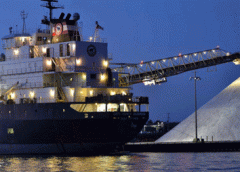Spring cargo numbers from the St. Lawrence Seaway and U.S. ports are signaling a better year for Great Lakes-Seaway shipping.
According to the latest figures from the St. Lawrence Seaway, total cargo shipments via the Seaway from the start of the shipping season (March 20 through April 30) reached 3.7million metric tons, up 8 percent from the same period a year ago.
Dean Haen, director for the Port of Green Bay, said, “The 2017 shipping season started early and strong with increases in cement, coal, salt and petroleum products.” Through April, the Port of Green Bay has seen a 31 percent increase in total domestic imports compared to 2016, largely due to the shipments of coal and cement. “We’ve also seen a strong increase in foreign imports thanks to additional salt shipments from Canada,” Haen added.
“It’s still very early in the season, but we’re optimistic that 2017 will be a better year for Great Lakes-Seaway shipping,” said Bruce Burrows, president of the Chamber of Marine Commerce. “U.S. iron ore pellet exports to Japan and China that started in the fourth quarter have continued this spring, while U.S. grain shipments remain relatively in line with last year’s strong performance. Road salt volumes are also up over 2016 levels as municipalities replenish their stockpiles throughout the region.”
Year-to-date iron ore shipments via the St. Lawrence Seaway totaled 800,000 metric tons, up 70 percent over 2016 levels, with Canadian domestic carriers loading U.S. iron ore pellets at Minnesota ports/docks to ship to Quebec, where the cargo is then transferred to larger ocean-going vessels for onward transport to Asia. Salt shipments via the Seaway (from March 20 to April 30) totaled 432,000 metric tons, up 20 percent over the same period in 2016.
U.S. Great Lakes ports are also reporting a solid start to spring operations. “Actually, it seems like the 2016 shipping season never really ended,” said John Loftus, executive director of the Detroit/Wayne County Port Authority. “With the mild weather that we experienced, barge loads of steel continued in January and February with both domestic and Canadian shipments.”
Joseph Cappel, vice president of business development for the Toledo-Lucas County Port Authority, said, “With 1.75 million short tons handled through April, iron ore and grain shipments are leading the way. A lot of people think that the port is idle during the winter months but that is certainly not the case. We were receiving iron ore vessels well into January and we started right back up again in March. Activity never stops at Toledo’s 19 active marine terminals. When vessel activity pauses, the facilities are busy handling rail cars and trucks and preparing for their next vessel.”
At the Port of Cleveland, there’s cautious optimism moving forward. “The Port of Cleveland began the 2017 shipping season with lighter volumes than April last year, but vessel traffic will increase significantly in May,” said Jade Davis, the port’s vice president – external affairs. “The Cleveland-Europe Express began its 4th year of service with three vessel calls in April and volume will continue to build in the coming months. Cleveland Bulk Terminal, now managed by Logistec, moved almost 300,000 tons of cargo in April, with further volume expected as we move toward the summer months.”

